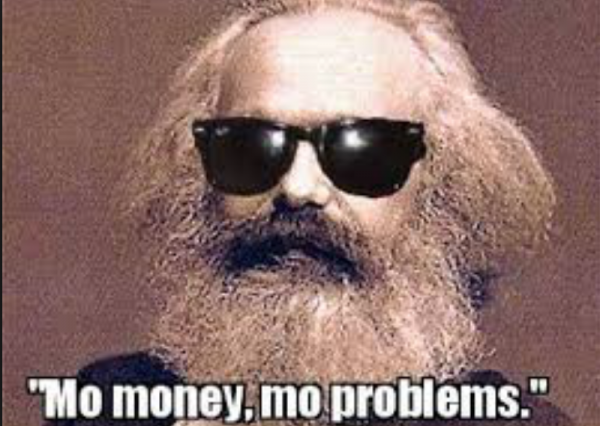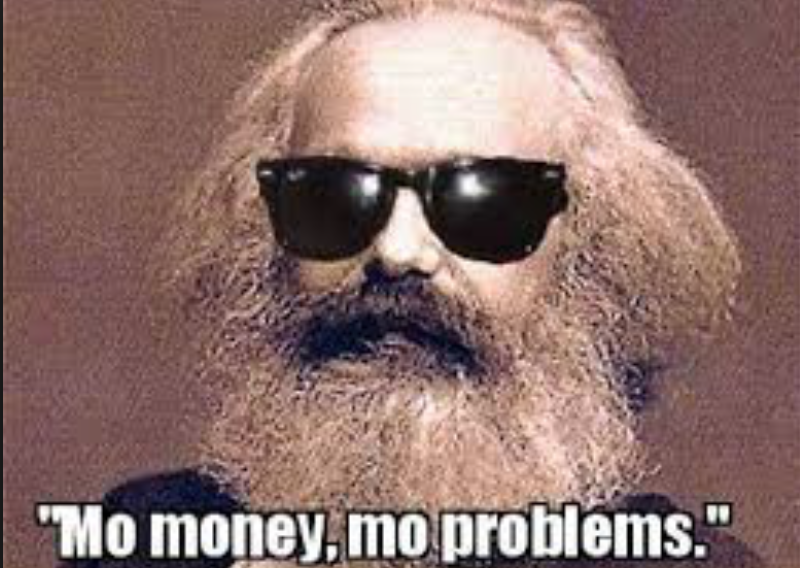
For Marx, even the best theory, without the Party testing it in the class struggle, was worthless dogma. The fusing of theory and practice demands a program that is tested by the Communist Party in the class struggle. In his lifetime, the revolutions of 1848 and the Paris Commune of 1871 were the most important practical tests that produced lessons requiring revisions of the program. By 1850, the proletariat had succeeded the now reactionary bourgeoisie as the revolutionary class. The bourgeois revolution could be advanced only by the proletarian revolution – the permanent revolution.
The Commune put this to the test. Its defeat strengthened the bourgeois counter-revolution and the impact of reformism on the workers’ movement. It proved that the bourgeois state had to be smashed and replaced by a workers’ state. Failure to learn these lessons frustrated Marx and his Critique of the Gotha Program in 1875 was a declaration of his Marxism against those who revised it by succumbing to bourgeois reforms.
This statement made a few months before his death in 1883, that if the reformists called themselves Marxist then he “was not a Marxist”, leaves no doubt as to what his Marxism was right up to the end. His friend and political collaborator, Engels, continued the fight to defend Marx’s Marxism from all sides in the struggle to keep it alive in the face of the opportunist, reformist tendencies in the Second International.
Engels, friend and collaborator
After Marx’s death, Engels, his lifelong collaborator continued the fight to resolve this crisis. He was faithful to Marx’s Marxism, completing and publishing three of the unfinished volumes of Capital (Vols 2,3 and 4 – or Theories of Surplus Value), in which Marx had fleshed out the foundations of his scientific theory so they could be understood and applied in practice to developing the Communist program. The importance of publishing these 3 volumes were that they demonstrated Marx’s method of moving from the abstract to the concrete.
Moving from the Vol 1. analysis of value which was ‘abstracted’ from the struggle over wages, prices and profits etc; Marx in Vol 2, showed how the production of value underlay the struggle over the distribution of value between Labour and Capital; and to Vol 3 to show how crises that appeared on the surface of capitalist society as unstable ‘chaos’, were determined by the TPRF. Engel’s major contribution was therefore to show how falling profits and not falling wages explained the ‘chaos’ of capitalism. Not only did this show that workers wage demands did not cause crises, rather it exposed the fact that capital could not exploit workers sufficiently to prevent recurring crises.
Therefore, workers had to understand Marx to recognize that capitalist crises could not be overcome; capitalism itself had to be overthrown. His determination to make Marxism comprehensible to ordinary workers, has seen him belittled as a ‘popularizer’ of Marx. Yet Marx himself would have done much the same had he lived, as shown by his pride in the reception of the serialized Volume 1 in the French Edition making it accessible to workers.
To illustrate this point, after their critique of the Gotha Program, Marx and Engels intervened in the debate against Herr Duhring, a minor academic who launched a reformist socialist program, attacking Marx among others. Engels’ book Anti-Duhring was serialized in 1877/78 as a response to this attack [2]. It explodes Duhring’s “bumptious pseudo-science” as “sublime nonsense”. Marx contributed the chapter “From the Critical History” in which he takes his opponent apart as an “ignorant plagiarist”.
Engels’ pamphlet Socialism: Utopian and Scientific, published in 1880 was a re-write of some sections of Anti-Duhring “suitable for immediate popular propaganda”. Marx clearly approved of these joint efforts since he wrote the Introduction to the French Edition praising it as “…an introduction to scientific socialism”. It proved very popular, selling 20,000 of the four German editions despite being banned under the Anti-Socialist Law, and was translated into 10 languages.
After Marx’s death Engels continued to intervene as the authority on Marx’s work in the debates that took place in the Second International. First, his Introduction to a new edition of Marx’s The Civil War in France (1891) restated the lessons of the Commune. Second, his ‘Foreword’ to the first publication of Marx’s Critique of the Gotha Program, (1891) aimed at the German Social Democratic Party leadership which tried to suppress the publication of Marx’s Critique because it exposed their break from Marxism. Third, Engels’ ‘science of socialism’ popularized Capital Vol 3 to explain crises, imperialism, colonialism, ‘bourgeois workers’, and the material roots of ‘social chauvinism’ in the Second International.
When Engels published Vol 3 in 1894 it was clear that the imperialism in the 1880s was the result of crises cause by the TRPF forcing the export of capital to restore profits. This accounted for super-profits extracted from the colonies that raised living standards for the working class, creating a privileged labour aristocracy made up of “bourgeois workers” as Engels called them.
Colonial super-profits explained the material roots of the labour bureaucracy and social democracy – the political expression of a layer relatively privileged worker-officials in the trades unions and in parliament. Lenin labelled the labour aristocracy as “social chauvinist” and “social imperialist”, promoting “parliamentary socialism at home and imperialism abroad”. Clearly, it was colonial super-profits that paid for ‘democracy’ in the imperialist countries.
These interventions were to lay the foundations for the next generation of Marxists whose task was to in effect to write Marx’s last three planned volumes – on The State, Foreign Trade, and the World Market and Crises – which accounted for the uneven and crisis-ridden expansion of world capitalism. They explain why the 2nd International degenerated into opportunism after Gotha and evolved into a reformist party with a bourgeois program. This opportunism was to lay the ground for what was to be the second crisis of Marxism, the betrayal of the proletariat by the majority of the Second International leadership on August 4, 1914.
Love Marxism, Love Leninism
After the death of Engels in 1895, the task of keeping Marxism alive fell to the next generation born in the late 19th century – notably Lenin, Trotsky and Luxemburg. To do that they had to develop Marxist theory as a guide to the class struggle in the new epoch of imperialism recognized by Marx and Engels. Marxism can only live when it is tested as a program of action by a Marxist party immersed in the struggles of the day. So, those who took over the leadership of the movement from Marx and Engels have to be evaluated as leaders who were capable of this task.
As mentioned above, we first have to evaluate their agreement with Marx and Engels on the major challenges to Marxism in their time – the Commune, and the Gotha Program. Lenin, Trotsky and Luxemburg took a Marxist stand on these questions, and condemned the anti-Marxist position of Kautsky and others who opposed the Communards’ taking up arms to overthrow of the French regime, in favour of parliamentary compromises. However, it is notable that their critique of Kautsky did not become urgent until the shock betrayal of the 2nd International in 1914.
This proved beyond doubt that even the most revolutionary Marxists were taken by surprise by the power of the labour bureaucracy in the imperialist countries that sided with its own ruling classes calling on workers to pay for the war and give their lives fighting worker against worker. In their defence, the three leaders were in exile in Europe, in the US, or in jail, and isolated from the European sections of the International.
The death of Marx had created the first crisis in Marxism; the betrayal of the 2nd International was a second crisis that nearly claimed the life of Marxism itself. Joining with the exploiting class to kill one’s fellow workers was a total rejection of Marxism. It was putting bourgeois national chauvinism ahead of international working-class solidarity. It was junking every lesson learned in the history of class struggles, that declare to the world that the proletariat and bourgeoisie have nothing in common. There could be no argument to justify going to war in the interests of the bourgeoisie. There was only one course open to save Marxism and that was to declare the 2nd International dead and begin the task of building a new one.
Zimmerwald Left
Those on the anti-war left of the International met at Zimmerwald. The majority opposed the war but took a subjective, pacifist line in voting against the evils of war while voting to pay for it, in the Reichstag. [examples] They were now reformists having succumbed to social imperialism – the view that imperialism abroad could be reformed by parliamentary socialism at home.
The minority, the Zimmerwald Left, around Lenin, Luxemburg and Liebknecht, argued to turn imperialist war into class war in which workers would refuse to fight one another and turn their guns on their own ruling class. The 2nd International was pronounced dead and a commitment to building a new international made. They all agreed that the betrayal of Social Democracy resulted from the creation of labour aristocracies (Engels’ ‘bourgeois workers’) bought off by colonial super-profits to promote social chauvinism at home in support of imperialist war. What to do?
The “three L’s” called for workers to mutiny and organise armed uprisings against the ruling classes in every imperialist country. Trotsky calls for workers to refuse to fight but did not think that workers are ready for armed insurrection. They disagreed on other aspects of Marxism too. Luxemburg and Trotsky, from right and left positions, rejected the Bolshevik Party as substituting for the proletariat.
Trotsky on the right saw the split between Bolsheviks and Mensheviks as unnecessary. He was known as a ‘conciliationist’ for advocating a united party. Yet at the same time Trotsky agreed with Lenin in rejecting the Menshevik two-stage theory, that the bourgeois revolution had to be completed by a class alliance with the bourgeoisie, before the socialist revolution was possible in Russia. They both agreed with Marx, that since 1850 the bourgeoisie was now a reactionary class. Therefore, the bourgeois revolution against the Tsar would have to be led by the proletariat as the revolutionary class and completed as the socialist revolution i.e., the uninterrupted, or permanent revolution.
Luxemburg from the left objected to Bolshevik democratic centralism as substituting for the spontaneous revolutionary consciousness of the masses. But from the right, however, her underconsumptionist theory of capitalist crisis ignored Marx’s theory of “the tendency of the Rate of Profit to Fall” (TRPF) in Capital Vol 3 published by Engels in 1894. Since for her falling profits was caused by underconsumption due to low wages, the spontaneous struggle for higher wages would bring about revolutionary class consciousness and the overthrow of capitalism.
Therefore, on the central question of the Party, both in their own way took one-sided views of democratic centralism against Lenin’s dialectical position which weighed-up all sides of the question. The Party is the subjective factor in the revolution, not the spontaneous mass “trade union” consciousness – which is an objective barrier to revolutionary consciousness that can only be transcended by the Party. Nor can the Party be united around a broad program that represents an objective, inevitable march from reform to revolution without the subjective vanguard party intervening to know when to advance and retreat.
Not until the Russian revolution proved them wrong did Trotsky and Luxemburg come around to Lenin’s position. Trotsky joined Lenin in July 1917 and became one of the main leaders of the Russian revolution. Luxemburg withdrew her objection to the Bolshevik type party and formed the Spartacist Party but was betrayed by Social Democracy in Germany and assassinated in 1919, cutting short the life of a true revolutionary, and contributing to the defeat of the German Revolution.
The October Revolutions in Russia and Germany
Lenin, as the leading revolutionary Marxist, advanced Marxism, against all backsliding comrades (Trotsky as conciliator; Luxemburg as spontaneist and underconsumptionist) and hostile class enemies (Social Democracy), by re-asserting its premises, re-reading Hegel, re-affirming the dialectical method, and applying the theory of Capital vol 2 and 3 to analyze the ‘concrete’ conditions in Russia (he read Marx on Sismondi to expose the petty bourgeois program of the Narodniks).
Lenin developed the theory of crisis in Vol 3 to explain the state of the world economy embedded in imperialism and war (Imperialism: the Highest Stage of Capitalism); the reactionary role of Social Democracy and Kautsky’s vacillating centrism (Renegade Kautsky etc); the class character of the State (State and Revolution); AND applied it to a Transitional Program put into practice by the democratic centralist Bolshevik Party.
Lenin embodied Marx because he fused theory and practice in the democratic centralist party in which objective and subjective reality was united. He used Marx’s dialectic method to defeat the objectivists and subjectivists whose role was to rely on old idealist formulae instead of the ‘art’ of revolution. He routed the objectivists who treated the proletariat as a passive rather than active participant in revolution.
Naturally, petty bourgeois upstarts substituted for the proletariat in deciding when the workers would be ready for revolution. So naturally, Lenin denounced the subjectivists (anarchists and left communists) who argue spontaneous proletarian class consciousness was sufficient to make the revolution, and that democratic centralism must lead to the Party substituting itself for workers democracy.
It follows that without Lenin in the leadership of a democratic centralist party there would have been no socialist revolution in Russia. It would have collapsed into objectivism or subjectivism; nor would Marxism have survived as a living political force. In February 1917, the Bolshevik leadership was tied to the old dogma of Plekhanov etc., that Russia must have a bourgeois revolution to prepare the conditions for socialism.
This dogma based on a doctrinaire application of Marx’s slogan that capitalism cannot be overthrown until it has completed its historic task and is no longer capable of developing the forces of production. Yet since 1850 Marx understood that the bourgeoisie was no longer the revolutionary class and had to be displaced by the proletariat as the new revolutionary class. So, if the pre-conditions for socialism still had to be created, that could only be done by the proletariat.
When it came to the concrete conditions in Russia this dogma was clearly out of touch with reality. The bourgeoisie was not strong enough to overthrow the Tsar and complete the bourgeois revolution. It was woman textile workers that began the strikes in February that led to the overthrow of the Tsar. Only the industrial workers, combined with the poor peasants and soldiers could advance the revolution by overthrowing capitalism.
Lenin challenged the doctrinaire leadership by going to the Bolshevik masses and convincing them that a socialist revolution was necessary to complete the bourgeois revolution even in backward Russia. In Russia 1917, the same mistake that saw the German bourgeoisie join forces with the feudal Junkers in 1848, had to be avoided at all costs. So like Marx in 1850, Lenin was affirming the validity of permanent revolution as the only way to take the bourgeois revolution forward to socialism in one continuous movement.
Permanent revolution was also tested by the failure of the German revolution. The first uprising in 1919 failed because of the Menshevik SPD formed a government with the ‘democratic’, ‘progressive’, but still warmongering, bourgeoisie. Then in 1921 the Communist Party (KPD) took part in a premature putsch that was easily suppressed.
By 1923 a revolutionary situation had returned. The KPD was better prepared, but its leadership vacillated and failed to size up the situation or prepare for insurrection on time, and the moment was lost. Having failed to make the revolution the responsibility for the rise of fascism in Germany then fell to the KPD leadership, mainly because it had not learned the lessons of the Bolshevik revolution and built a strong, democratic-centralist party in time.
Left Opposition and Fourth International
With the failure of the German revolution, the most important condition for the success of the Russian revolution disappeared. The industrialization of the Soviet Union was setback by the backwardness and war devastation in both industry and agriculture. The Bolsheviks had to keep the revolution alive in an isolated, under-developed country without international support. The only way out was to fight for a democratic-centralized plan for industry and agriculture to develop the forces of production and survive until revolutions succeeded in Europe or Asia. For the Bolsheviks there was never the possibility of socialism being built in one country.
After the death of Lenin in 1924, the battle to claim his legacy was the key to the life and death struggle between the growing bureaucratization of the party and state apparatus under Stalin that appeased the petty bourgeoisie and surviving bourgeoisie, and the Left Opposition led by Trotsky, which insisted that workers democratic control of the soviets and of the Party regime as pre-conditions for planning production in industry and agriculture, allowing the forces of production to grow, reducing necessary labour-time, and making the building of socialism possible.
The record of the Bolshevik Leninists from 1923 to 1933 was of a life and death struggle to challenge the Stalinists regimes break from ‘Leninism’ as it subordinated world revolution to popular fronts with the bourgeoisie around a Menshevik program for ‘national roads’ to socialism in defence of ‘socialism in one country.’ From the betrayal of the German Revolution in 1923, to the Chinese Revolution, 1924/1927, the challenge of the LO was met with mounting repression, exile and execution of its militants. Among them was Trotsky expelled and exiled in 1927, and then assassinated in 1940.
The Left Opposition became an International Left Opposition (ILO) as an internal opposition inside the Comintern. It fought to restore workers democracy against the bureaucratic regime until 1933 when Stalin’s policy to appease fascism in Germany helped the Nazi’s come to power. This betrayal of the international communism was of the same order as the 4th of August 1914 had been for the 2nd International and forced the ILO to declare the Comintern dead, and call for the building of a new, Fourth, International.
From 1933 the ILO was committed to building a new revolutionary international to take the leadership of the world revolution, fighting for political revolution to overthrow the bureaucracy in the Soviet Union, and for socialist revolutions based on workers’ and peasants’ soviet governments everywhere. The Fourth International was formed in 1938 based upon a Transitional Program keeping the legacy of Marxism and Leninism alive, and dedicated to the unconditional defence of the Soviet Union, the political revolution and the international revolution.
Conclusion: The Short 20th Century
For Marxism after Marx, it is the onset of the epoch of imperialism that explains the inevitability of recurring crises, revolutions, counter-revolutions and wars. Arising out of WW1 the rise and fall of the Russian revolution became the ultimate test of the power of revolutionary Marxism. The British historian Eric Hobsbawn, talks of the “Short 20th Century” from the Russian revolution of 1917 to the restoration of capitalism in 1991, as shaping the fate of the modern world. Indeed, there is some truth in this. The October revolution proved that Marxism could keep the 19th century theory of Marx alive in the form of a revolution led by a Marxist party. Its success proved that a dying capitalism could be replaced by a socialist revolution. But was the rise of Stalinism the end of the road for Marxism?
No. The degeneration of the revolution also vindicated the living Marxism of the ILO. Neither the revolution nor the counter-revolution can be understood except as a partial and incomplete advance of the permanent revolution Marx spoke of in 1850. The proletariat made the revolution along with the poor peasants, against the counter-revolution of world capitalism and the united exploiting classes. While we can talk about the Russian revolution succumbing to counter-revolution as the culmination of the Short 20th century, it is only part of the larger historic dynamic of permanent revolution from the mid-19th century to today, and beyond.
For Marx permanent revolution did not mean only that the working class must to lead the exploited and oppressed classes to the revolution against all the exploiting and oppressing classes. It meant that the revolution could not be realized fully without the victory of the international revolution, and finally without the victory of world socialism and the prospect of a future communist, classless, and stateless, society. Not until then, will the Manifesto of the Communist Party and permanent revolution end up in the museum of class struggle. Until then, it is the task of Marxists to continue the fight for permanent revolution.
To be continued: Part 3: Marx Today.
Part One: https://thedailyblog.co.nz/201
Dave Brownz is TDBs guest Marxist because every left wing blog needs a Marxist.





